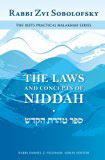
The Laws and Concepts of Niddah, by Rabbi Zvi Sobolofsky, is what its title claims it to be. In this expansive work (304 pages in English by the author, 20 pages of additional opinions in English and another 278 pages of sources in the original Hebrew), the author goes step by step through key concepts of the laws of niddah. For each concept, the relevant halachic debates are brought in detail, complete with an erudite rendition of the stages of each argumment.
However, the strength of the book is also its weakness for the general population. In order to properly understand the book, one needs to be reasonably grounded in the laws in the first place. For example, the book jumps into the onset of niddah presuming that one already knows the existence of this status. There is no preamble to the involved discussion of the implications of “seeing blood” (from where?) with or without hargasha.
The knowledge assumed by the book is understandable if the members of the intended audience are those who are already immersed in the field of halacha. For them, this book is a very useful resource for understanding the halachic history behind disparate rulings in hilchot niddah. Unfortunately, however, it does not delve in enough depth into modern day, practical applications of which this audience needs to be made aware. Thus, for example, the halachic implication of a veset caused by hormonal contraception is discussed, but there is no description of the multiples forms of hormonal contraception that exist today or of the different ways they can be administered. The book states (page 241) “ since a woman who is taking birth control pills will bleed every 28 days like clockwork, it is regarded as a vest kavuah”. There is no discussion of the common practice of extended time of use (in which case she will NOT bleed every 28 days like clockwork) or any mention of current kinds of hormonal contraception such as patches or vaginal rings.
In addition to the expansive halachic discussion by Rabbi Sobolofsky, the book is also a unique written resources for the halachic opinions of a number of the leading figures of Yeshiva University, Rabbis Hershel Shachter, Mordechi Willig and Yaakov Neuberger. These opinions are recorded even when they disagree with those of the author.
In summary, this book is an important addition to the growing list of books on the topic of hilchot niddah. However, it should definitely not be the first book used to learn how to keep these laws on a practical level.
Dr. Deena Zimmerman currently works as a pediatrician for Maccabi Health Services and TEREM-Immediate Medical Care in Israel, and is Medical Advisor to the Jerusalem Breastfeeding Center. Dr. Deena Zimmerman, a doctor at TEREM and lactation consultant, is a yoetzet halacha (halacha consultant) and medical advisor of Nishmat’s Women’s Health and Halacha websites.








Leave A Comment